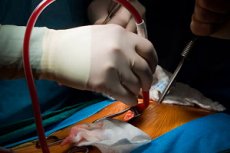Medical expert of the article
New publications
Pericardial separation
Last reviewed: 29.06.2025

All iLive content is medically reviewed or fact checked to ensure as much factual accuracy as possible.
We have strict sourcing guidelines and only link to reputable media sites, academic research institutions and, whenever possible, medically peer reviewed studies. Note that the numbers in parentheses ([1], [2], etc.) are clickable links to these studies.
If you feel that any of our content is inaccurate, out-of-date, or otherwise questionable, please select it and press Ctrl + Enter.

Pericardial separation refers to a surgical procedure in which the pericardial sheets are first separated and then sutured. In this case, fluid accumulation occurs between the pericardial sheets, which is the reason for the operation. The pericardial sheets are separated, and if necessary, some of them are removed. There are 2 sheets in the pericardium, so the main manipulations are performed exactly with these layers. Separation is the separation of the pericardial sheets, their divergence. At the same time, fluid (exudate) can accumulate between them. Therefore, in this case, we can talk about both a pathological condition in which the pericardial sheets diverge, and a surgical procedure in which the sheets are deliberately separated and then sewn in the correct order. The pathologic fluid must be removed.
When the pericardium separates, an inflammatory process inevitably develops. The disease can occur in both acute and chronic forms. As the main symptom is a sharp pain in the heart area. Also the process is accompanied by a violation of blood circulation, nutrition of the heart muscle. In this case, there is often an intense accumulation of fluid between the separated layers of the pericardium. This condition is dangerous, because as a complication, cardiac tamponade can develop, in which there is a strong compression of the heart muscle. Separation of the pericardium can lead to impaired blood circulation, nutrition, up to the development of infarction, necrosis of some parts of the heart. In such a situation, the patient needs emergency care, the essence of which is to perform surgery.
It is worth noting that pericardial separation occurs against the background of common somatic diseases, such as rheumatism, angina, pneumonia, bronchitis. Often pericardial separation is a consequence of infectious diseases, in particular, of bacterial and viral origin, occurs against the background of immunodeficiencies. One of the main signs of pericardial separation is the accumulation of fluid and the development of a pronounced inflammatory process, since a cavity is formed between the separated layers. It should also be noted that with separation, the contraction of the heart muscle becomes more difficult, friction of the heart membranes occurs, and the likelihood of wear and tear of cardiac tissue increases. It is also worth noting that during the separation of the pericardium, the pathologic fluid may be purulent or exudative in nature. If there is an excessive amount of fluid during the separation of the layers of the pericardium, it is necessary to urgently perform surgery and pump out the accumulated fluid, as this can be fatal.
It is also worth noting that pericardial separation can be one of the signs of more severe heart disease, for example, can be a sign of the development of heart failure or a precursor to a heart attack. Therefore, this condition should be urgently paid attention to, take appropriate measures. Often pericardial separation is accompanied by many inflammatory and infectious processes that are not related to the heart. For example, pericardial separation can occur as a result of trauma, and can also be a consequence of autoimmune aggression (for example, in lupus, rheumatism).
Pericardial separation is often difficult to diagnose, as this process can be considered as an independent disease, separation can be a sign of other heart diseases. Sometimes pericardial separation develops as a consequence of prolonged treatment with certain drugs, or as a result of serum sickness. Separation of the pericardium can appear against the background of intoxication, as a consequence of radiation therapy or chemotherapy, with prolonged treatment with heavy drugs that have a toxic effect on the body. As the main symptoms of pericardial separation are such phenomena as shortness of breath, palpitations, a sense of weakness, chills. In some cases, body temperature may rise.
Treatment is prescribed exclusively by a cardiologist, because there are many nuances that need to be taken into account. Thus, in many respects, the treatment tactics depend on the form, stage of the disease, peculiarities of its course. With an intense and rapid accumulation of fluid between the sheets that have separated, mandatory puncture and drainage of the heart cavity is carried out. In most cases of separation of the pericardium, mandatory surgical treatment is carried out, in the process of which the accumulated fluid is removed and suturing of the separated layers is done.

